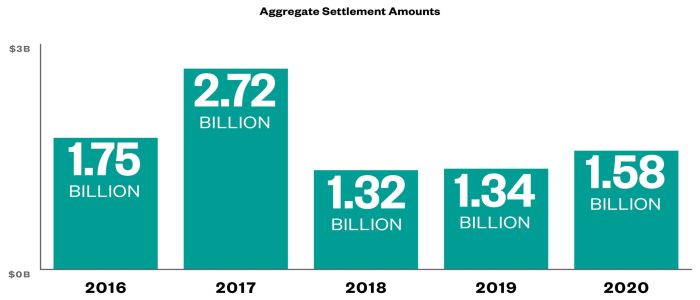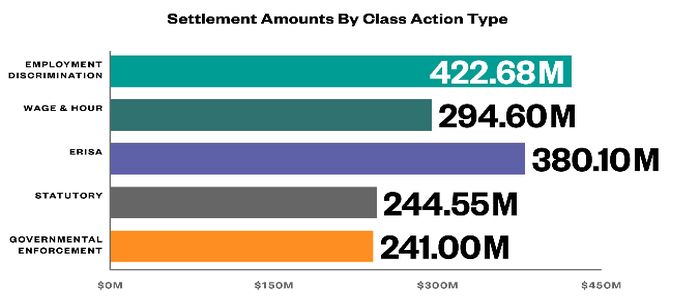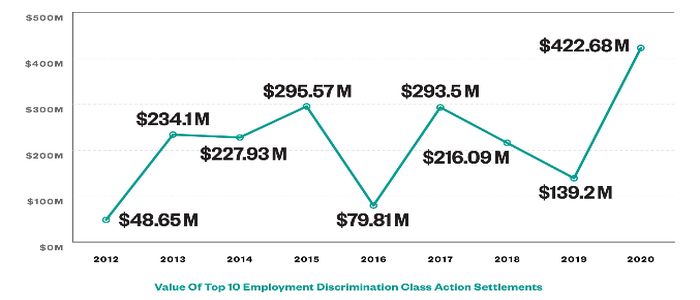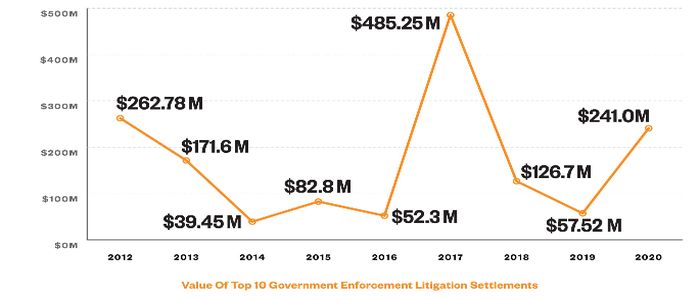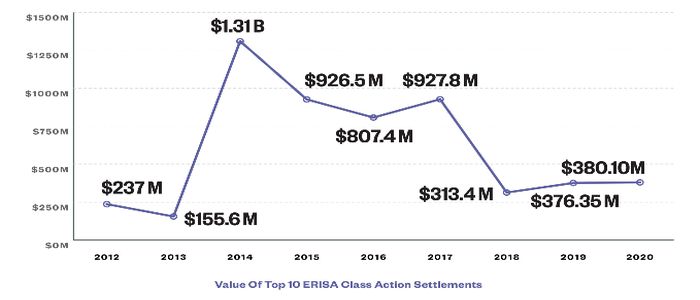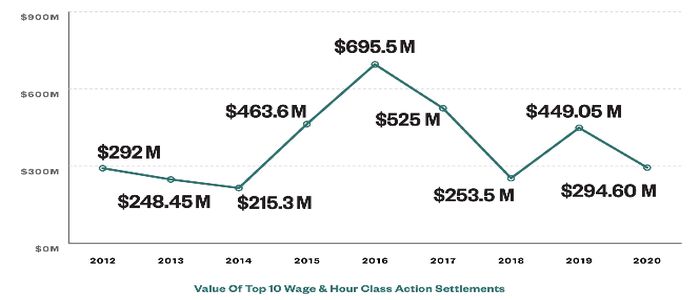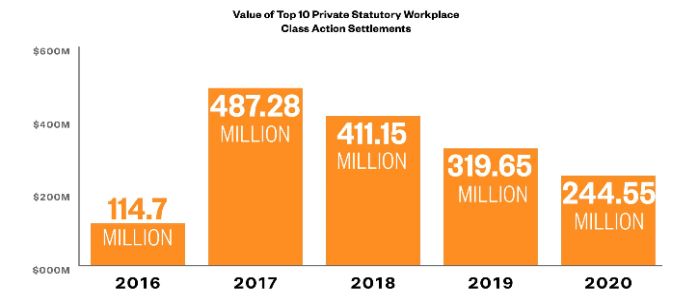Seyfarth Synopsis: In our continuing series of discussion points from the 2021 Workplace Class Action Litigation Report, somewhat counter-intuitively, the aggregate monetary value of workplace class action settlements increased in 2020, as settlement numbers went up and plaintiffs' lawyers and government enforcement actions monetarized their claims at higher rates. Many employers and commentators alike expected the pandemic to depress the size and pace of settlements in the new "cash is king" approach to the business cycle. Instead, workplace class action litigation defied the odds.
As measured by the top ten largest case resolutions in various workplace class action categories, overall settlement numbers increased in 2020, as compared to the prior two years. After settlement numbers reached an all-time high in 2017, those numbers fell dramatically in 2018, and then leveled off in 2019.
Although many employers and commentators alike expected the pandemic to depress the size and pace of settlements even further as businesses sought to conserve cash in the wake of the COVID-19 pandemic, workplace class action settlements defied expectations.
The numbers show that, in 2020, the plaintiffs' bar was successful in monetizing their class action filings at a higher level than the past two years, perhaps signaling the beginning of an upward climb toward the numbers we saw in 2016 and 2017.
These trends harken back to the U.S. Supreme Court's 2011 decision in Wal-Mart, Inc. v. Dukes, 564 U.S. 338 (2011). By tightening Rule 23 standards and raising the bar for class certification, Wal-Mart made it more difficult for plaintiffs to certify class actions and, as a result, more difficult to convert their class action filings into substantial settlements. These barriers became more formidable in 2018 with the Supreme Court's ruling in Epic Systems v. Lewis, which upheld the validity of class action waivers in mandatory workplace arbitration agreements.
The "Wal-Mart/Epic Systems" phenomenon provided employers a "one-two punch" relative to their defense strategies that continues to impact the contours of class action litigation in 2020. To that end, federal and state courts cited Wal-Mart in 673 rulings in 2020, and they cited Epic Systems in 189 decisions by year's end.
This past year, the plaintiffs' bar continued to identify and develop work-arounds that helped to force the settlement of high-value class actions in multiple areas. Considering all types of workplace class actions, settlement numbers in 2020 totaled $1.58 billion, an increase compared to settlements in 2019, which totaled $1.34 billion, and from 2018, when they totaled $1.32 billion. These totals, however, remain significantly lower than their high-water mark in 2017, when such settlements topped $2.72 billion, and slightly lower than 2016, when such settlements totaled $1.75 billion. The following graphic shows this trend:
In terms of the story behind the numbers, the breakouts by types of workplace class action settlements are instructive.
In 2020, we saw a significant upward trend regarding the settlement values of employment discrimination claims, government enforcement litigation, and a slight upward trend regarding ERISA class actions. In contrast, we saw significant decreases across-the-board for resolutions of class actions involving wage & hour claims and private statutory claims.
The results in these categories are illustrated by the following chart for 2020 settlement numbers:
By type of case, settlement values in employment discrimination class actions and government enforcement cases experienced the most significant increases.
Employment discrimination class action settlements showed a significant increase in 2020. The top ten settlements totaled $422.68 million, as compared to $139.2 million in 2019, $216.09 million in 2018, and $293.5 million in 2017. The comparison of the settlement figures with previous settlement activity over the last decade is illustrated in the following chart:
In 2020, the value of the top ten largest employment discrimination class action settlements of $422.68 million was the highest figure reached since we began tracking numbers, and $76.28 million higher than the next highest year recorded (2010).
As such, 2020 represents the reversal of a trend that started in 2011 (after Wal-Mart was decided) that kept the value of the top ten settlements under $300 million in each of the subsequent nine years.
Relatedly, the top ten settlements in government enforcement litigation experienced a sharp upward turn in 2020, as it increased to $241.0 million, a significant jump from the $57.52 million we saw in 2019 and from the $126.7 million recorded in 2018. Although the numbers did not approach the 2017 high-water mark of $485.25 million, they outpaced the numbers lodged in every other year since 2012.
This trend is illustrated by the following chart of settlements from 2012 to 2020:
ERISA class action settlements rose slightly in 2020. The top ten settlements totaled $380.10 million, which topped the 2019 total of $376.35 million, as well as the 2018 total of $313.4 million. ERISA settlements in 2020, however, remained well below prior years, including the $1.31 billion we saw in 2014, the $926.5 million we recorded in 2015, the $807 million we saw in 2016, and the $927.8 million we logged in 2017. Given that ERISA class action settlements over the four-year period from 2014 through 2017 averaged $992.93 million, 2020 continues a trend toward a lower conversion rate for the plaintiffs' bar.
This trend is illustrated by the following chart of settlements from 2012 to 2020:
The upward year-over-year trend did not hold for wage & hour class action settlements. The value of those settlements in 2020 fell off significantly from the previous year. In 2020, the value of the top ten wage & hour settlements was $294.60 million, compared with $449.05 million in 2019.
Although a significant decrease from 2019, the value held slightly above the lowest levels of the past decade, including above four of the past eight years with values of $292 million (2012), $248.45 million (2013), $215.3 million (2014), and $253.5 million (2018).
On a comparative basis, the top 10 settlements in 2020 likewise fell well short of the spikes we saw in the other four of the previous eight years, with values of $463.6 million (2015), $695.5 million (2016), $525 million (2017), and $449.05 million (2019).
When combined, however, the top 10 wage & hour settlements for the three-year period of 2015, 2016, and 2017 totaled over $1.68 billion. Adding 2018 and 2019 settlements, corporate America saw over $2.386 billion devoted to settling the top 10 wage & hour settlements over that five-year period.
As the impact of the 2018 ruling in Epic Systems continues to provide defenses for businesses inclined to adopt mandatory workplace arbitration programs with class action waivers, and cases filed prior to such adoption continue to work their way out of the pipeline, we could see settlement numbers continue to follow a downward trajectory in 2021.
The top ten settlements in the private plaintiff statutory class action category (e.g., cases brought for breach of contract for employee benefits, workplace antitrust laws, or statutes such as the Fair Credit Reporting Act or the Worker Adjustment and Retraining Notification Act) likewise fell off in 2020. The settlements totaled $244.55 million, which represented a significant decrease from 2019 and the continuation of a downward year-over-year trend that began in 2018. In 2017, such settlements totaled $487.28 million; in 2018, they totaled $411.15 million; and in 2019, they totaled $319.65 million.
The following chart tracks these figures:
Settlement trends in workplace class action litigation are impacted by many factors. In the coming year, settlement activity is apt to be influenced by developing case law interpreting U.S. Supreme Court rulings such as Epic Systems, the Biden Administration's labor and employment enforcement policies, case filing trends of the plaintiffs' class action bar, and class certification rulings.
The content of this article is intended to provide a general guide to the subject matter. Specialist advice should be sought about your specific circumstances.


